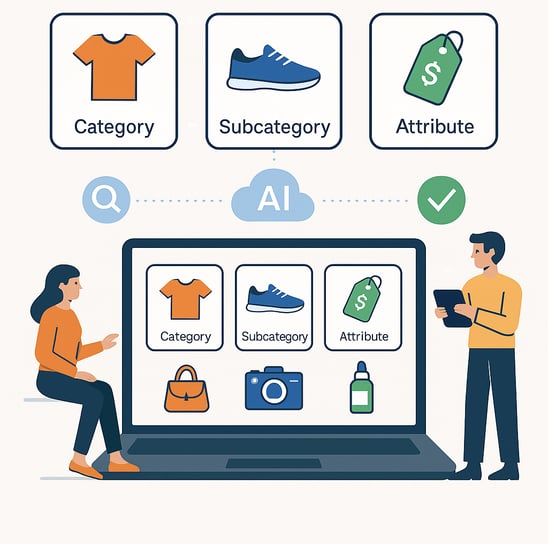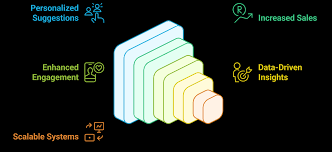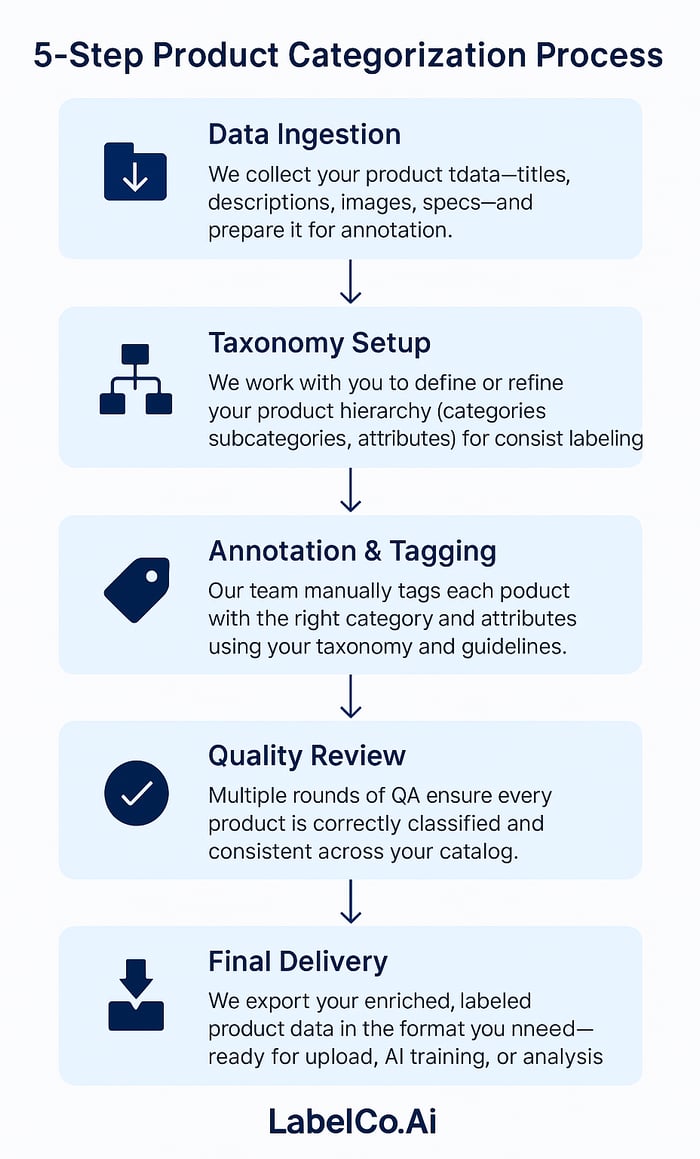Product Categorization
Clean, Consistent, and AI-Ready Product Data for Smarter Shopping Experiences
At LabelCo.Ai, we specialize in helping businesses organize and label their product data with precision. Whether you're managing 500 SKUs or 5 million, our product categorization services ensure your data is accurate, searchable, and ready to drive better customer experiences and AI performance.
We turn messy, inconsistent product listings into well-structured, easy-to-navigate datasets for e-commerce platforms, retail analytics, and digital catalogs.
What is Product Categorization
Product categorization is the process of tagging and classifying items into the right categories, subcategories, and attributes. Think of it as organizing your digital store shelf, so customers and AI systems can quickly find what they’re looking for.
Why Brands Choose LabelCo.Ai?
High-accuracy, scalable annotation teams
Fast turnaround for large product updates
Tool flexibility (your platform or ours)
Data privacy and custom NDAs
Expertise in industry-specific taxonomies


150+
250+
Annotators Onboarded
Happy clients
Why Product Categorization Matters?
Product categorization plays a crucial role in the success of e-commerce platforms. By enabling smarter recommendations, better product discovery, and more relevant search results, it significantly enhances the customer experience. This directly impacts conversion rates and overall profitability. To build an effective categorization system, businesses need access to a well-labeled, high-quality dataset that accurately represents the product catalog.
Boosts Search Engine Optimization (SEO) and Navigation


Accurate categorization helps customers find products quickly, improving user experience and reducing drop-offs.




Enhances AI and Recommendations
Clean, structured data allows algorithms to deliver smarter search results, filters, and personalized suggestions.
When customers find exactly what they need, they’re more likely to buy—and less likely to return due to confusion or mislabeling.
Drive Sales and Reduce Returns


How LabelCo.Ai Delivers Smart Product Categorization at Scale?
At LabelCo.Ai, we understand that clean, consistent, and accurate product data is at the heart of every high-performing e-commerce platform. Our product categorization process is designed to organize, standardize, and enrich your catalog—making it easier for customers to find what they need, and for AI systems to process, recommend, and personalize at scale.
Ingest and Understand your Product Data
We begin by collecting and analyzing your product information—titles, descriptions, specifications, metadata, and images. Whether your catalog has hundreds or millions of SKUs, we can onboard your data in bulk, through CSV, API, or platform-specific connectors (like Shopify, Magento, etc.). Our system prepares the data for annotation by cleaning inconsistencies and structuring it in a uniform format.
Build or Adapt your Product Taxonomy
We either work with your existing category tree or help create one from scratch. This includes organizing products into clear, multi-level categories and defining key product attributes such as color, material, brand, size, function, or usage. Our team ensures that the taxonomy reflects your business goals, industry standards, and customer search behavior.
Attribute Based Categorization
In machine learning, attribute categorization helps classify products based on specific predefined traits like brand, material, color, or type. This improves product recognition for users and ensures that search results are more accurate and relevant.
Gender Based Categorization
To deliver more personalized shopping experiences, it’s important that AI systems can identify which products are relevant to different genders. Our annotators train machine learning models to understand gender-based preferences—helping platforms recommend the right products to the right audience.
Object Categorization from Images
Object categorization is the process of training AI to recognize and classify items based on visual data. Using product images, our team helps models identify and assign products to the correct categories, even when items are visually similar. This is especially useful for e-commerce image search and automated cataloging.
Annotate and Label with Precision
Our trained annotators carefully classify each product into the correct category and tag relevant attributes. Whether it’s distinguishing between a running shoe and a casual sneaker, or tagging technical specifications in electronics—LabelCo.Ai’s team ensures high accuracy through domain expertise and strict labeling guidelines. We also support multilingual categorization to serve international marketplaces.
Multi-Level Quality Assurance
Every dataset goes through rigorous multi-stage quality checks. Our QA team uses sampling, spot-checks, rule-based validations, and AI-assisted tools to catch and correct inconsistencies. We guarantee clean, complete, and contextually accurate categorization that aligns with your taxonomy and business logic.
Deliver Ready-To-Use AI Friendly Data
Once labeled, your enriched product data is delivered in the format you need—JSON, XML, CSV, or direct API integration. Whether you're uploading it to your e-commerce backend or feeding it into a recommendation engine or search algorithm, your data will be optimized and ready for action.
Common Use Cases
1. E-commerce Marketplaces (Amazon, Flipkart, eBay)
Scenario:
A customer is searching for “men’s running shoes.” Without proper product categorization, the search may return unrelated items like sandals, women’s heels, or hiking boots.
Use of Categorization:
Products are categorized by gender, category, subcategory, brand, color, and use case. This improves search results, filters, and personalized recommendations.
Result:
Better discoverability → higher conversion rates → fewer returns due to mismatches.
2. Grocery Delivery Platforms (Instacart, BigBasket)
Scenario:
A user wants to filter only organic or vegan products in the dairy section.
Use of Categorization:
Categorizing by product type (milk, yogurt), dietary labels (vegan, organic), packaging (tetra pack, glass bottle) helps improve navigation and filter accuracy.
Result:
Simplifies the shopping experience and supports lifestyle-based buying behavior.
3. Fashion & Apparel Stores (Zara, Myntra, H&M)
Scenario:
A shopper searches for “formal black dresses for women” for an office party.
Use of Categorization:
Tagging products based on gender, style (formal/casual), color, size, fabric, and occasion makes this possible.
Result:
Users find what they want faster, increasing satisfaction and boosting sales of complementary items (e.g., accessories).
4. B2B Product Catalogs (Grainger, Uline, IndiaMART)
Scenario:
A corporate buyer is sourcing “industrial-grade rubber gloves with chemical resistance” for factory use.
Use of Categorization:
Products are classified by industry, application, material, safety rating, and size.
Result:
Accurate procurement decisions → Reduced support calls → Increased buyer trust.
5. AI/ML Product Training Data
Scenario:
A tech company is building a product recommendation engine and needs a structured product catalog to feed into the model.
Use of Categorization:
Tagging products by hierarchies, specifications, keywords, and tags enables AI to recognize patterns and improve recommendations.
Result:
Smarter algorithms and more personalized shopping experiences.
6. Point-of-Sale & Inventory Management Systems
Scenario:
A small retail chain wants to automate stock-level alerts based on product movement and seasonal demand.
Use of Categorization:
Grouping by department, product type, SKU, and sales seasonality allows backend systems to optimize reorder points and display trends.
Result:
Less overstock, fewer out-of-stock situations, and higher inventory ROI.
7. Review Aggregators & Comparison Sites
Scenario:
A user visits a platform like CNET or TechRadar to compare laptops under ₹50,000 with SSDs and backlit keyboards.
Use of Categorization:
Categorizing products by price range, hardware features, brand, use case (gaming/work), and ratings enables quick comparisons.
Result:
Faster decision-making for users and higher click-throughs for affiliate businesses.
8. Subscription Box Services
Scenario:
A customer signs up for a monthly beauty box and chooses preferences like cruelty-free, skincare, and age 30+.
Use of Categorization:
Items must be labeled by category, skin type, ingredients, brand ethics, and demographic fit to match customer profiles.
Result:
Better personalization and higher customer retention.
Frequently asked questions
What types of attributes can be tagged during categorization?
Answer:
LabelCo.Ai can tag product attributes such as category, brand, gender, color, size, material, style, price range, usage type, and more. We support both custom and standardized taxonomies.
Can LabelCo.Ai handle multilingual product data?
Answer:
Yes, we support product categorization in 150+ languages, ensuring accuracy and consistency across global marketplaces and multilingual platforms.
Can you categorize both images and text-based product data?
Answer:
Yes. We can categorize products based on titles, descriptions, specifications, and images—using either your taxonomy or one we help design. This enables more accurate classification and better visual merchandising.
Do you support custom taxonomies?
Answer:
Absolutely. We can adapt to your existing taxonomy or help you build a custom product hierarchy that aligns with your catalog structure and user journey.
Is your categorization process AI-powered?
Answer:
Yes. We combine AI-assisted tagging with human-in-the-loop validation to ensure high accuracy and scalability. This hybrid approach balances speed with precision.
LabelCo AI
Expert data annotation for AI and machine learning.
Contact
HELLO@labelco.ai
+91-9711151086
Get a custom quote for your annotation project
© 2025. All rights reserved.
